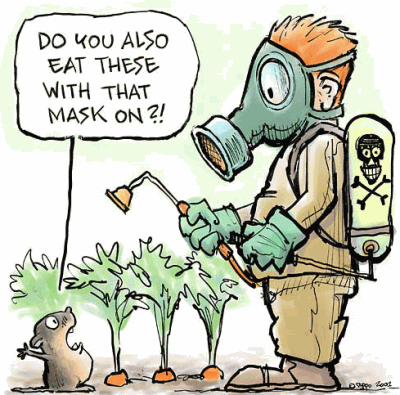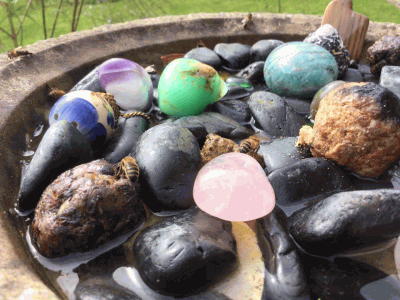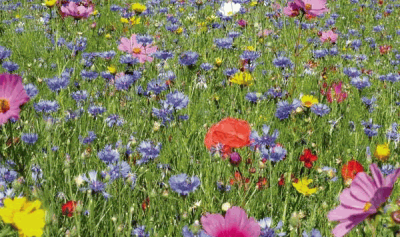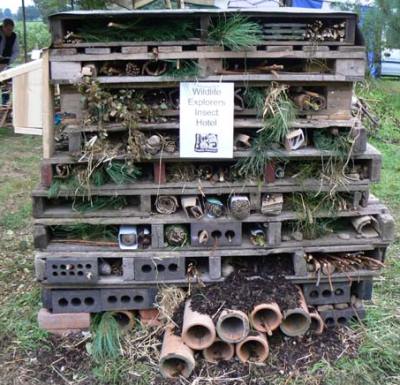Help the Bees
There are many ways we can try to help the bees. These ideas will help other wildlife too and maybe help with human survival.
Be an ARK
Acts of Restorative Kindness: You can make a haven of biodiversity in your garden. See the ARK website for more details, where you can download a printable logo to explain your 'messy' garden to neighbours.
Here are a few other ideas:
Don't Use Pesticides, Fungicides or Herbicides in your garden

This seems the obvious place to start. If you know someone who does, try to persuade them not to. Write to your local council and ask them not to use pesticides, fungicides or herbicides in the parks and gardens.
Try to buy organic produce when ever possible. Or grow your own. Or join a community allotment like the one at Redacre in Mytholmroyd.
Trees support a lot of wildlife and are attractive to look at and beneficial to health. You might consider joining a local tree planting group such as Trees for Burnley. See the links page for some ideas.
Scrap Your Mower
Lawns were originally designed as a way to show off your wealth: demonstrating to your neighbours that you could afford to have unproductive land that needed a lot of maintenance.
The invention of the lawnmower made lawns affordable for more people in terms of effort, but it didn't make lawns a good idea!
A lawn is an environmental desert. OK, it is better than decking, but that's not saying much. Get rid of it: grow wild flowers in a sort of a meadow and enjoy the pretty blossoms, the natural environment – and save all those hours of mowing. Or at least limit your mowing to pathways, leaving the rest to grow.
Plant for Wildlife
Learn which plants and flowers are useful for wildlife and put some in your garden. There are many flowers which are useful for bees and butterflies. Some also provide berries and seeds for birds and small mammals.
Make some seed bombs or seed balls. These are mixtures of clay (or other moisture retaining substance), compost and organic wild flower seeds made into a ball shape. You can sow these in waste land and hopefully raise useful plants for wildlife.
Make sure what you plant is pesticide free!
It is not enough to just choose bee, butterfly or wildlife 'friendly' plants.
Check that plants you buy are pesticide-free and grown in peat free compost. Many plants and seeds from supermarkets and garden centres are not organic. This means that the seed, the plant or the compost might have been treated with pesticides.
Some of these are 'systemics' including the neo-nicotinoids which are present in all parts of the plant including the nectar, pollen, leaves, fruit, seeds etc. So any part of it is poisonous to wildlife. Look for organic plants and seeds.
Beware of misleading labels
The 'type' of plant may be useful to wildlife but the way it has been grown may not. There are very confusing signs in garden centres. The RHS (Royal Horticultural Society) has a 'Perfect for Pollinators' signs which plant suppliers can display. This indicates a suitable variety of plant, but does not mean the plant is not harmful.
The RHS has confirmed that the plants can be treated with any pesticides or other chemicals (provided that it isn't against UK or EU law to use that treatment) and still bear the label. Which means that the label is worthless: some 'Perfect for Pollinators' labelled plants could kill pollinators. Be sure to check beyond the worthless RHS label!
Even small things can make a difference

You don't have to have a huge garden to attract wildlife. Even a few pots with some bee friendly flowers and a safe source of water can attract many small creatures.
You can make a safe water supply. Make some drainage holes part way up the sides of a shallow container, so that when it rains it doesn't overfill. Collect pebbles, interesting shells, marbles etc and put them in, then fill it with water. Bees and other small creatures can sip water from the safety of the pebbles. This saves them from drowning.
Provide a Habitat

A garden is of little use to wildlife if it consists of carefully manicured lawns, decking areas, concrete paving or tarmac.
Why not turn your lawn into a mini meadow full of native plants which are attractive to insects, birds and butterflies? These only need mowing once a year after the plants have flowered and set seed. The time you save cutting the lawn, you can spend watching wildlife instead!
Find a way of bringing water into the garden. Even quite a small pond will attract frogs, toads, newts, dragonflies, bees, damselflies and other creatures.
Don't cut bushes, trees and hedges in the spring when birds are nesting.
Provide a home
We are keen to encourage bees to build homes in places where they will be allowed to "just bee". You may consider having your own colony of honeybees in your garden. If you have space and like the idea, then we are happy to talk to people about how to keep honeybees naturally with as little interference as possible. Do get in touch.
If you live within a reasonable distance of us, perhaps you could offer a site for one of our hives? You wouldn't have to do anything except provide the space for the hive. If that sounds of interest, please get in touch and we'll be happy to discuss the possibilities.

If you don't feel ready for a hive of honeybees, maybe you could provide homes for wildlife in your garden? A solitary bee box, a bumble bee house, bird boxes, bat boxes etc. Or simply a pile of old twigs, leaves and logs to make a habitat pile. Be a bit messy with your gardening; don't clear up too much debris, then all sorts of creatures can take up residence.
You could use your imagination and make a magnificent wildlife hotel like this one made by Macclesfield RSPB!
If you don't want a honeybee colony, you might like to get a red mason bee nest. These bees do not have stings and are excellent pollinators. They are also fascinating to watch. A simple bee nest only costs a few pounds or if finances allow, you can buy one which has an observation window. There is more information via the links page.
Tell people about the Bees
Let people know what you know about the bees. Tell them about things you have done to help them and maybe they will follow your example and do something too.
If you have any ideas about helping bees or wildlife in general, please get in touch and let us know.